Purpose
Fellowship designed specifically to support outstanding scientific training for individuals who will begin or are just beginning a new postdoctoral training period in a given laboratory or research environment.
The NINDS F32 is different from the parent NIH F32
The NINDS F32 has different requirements, instructions for both candidates and mentors, and review criteria than the parent NIH F32. Applicants are strongly encouraged to read the program announcement carefully and completely.
Program Announcement
PAR-25-234
Due Dates for Applications (new and resubmissions have the same due dates)
2025: February 10, June 9, and October 9th
2026: February 9, June 9, and October 9th
2027: February 9, June 9th and October 8th
Eligibility
Applicants are eligible to apply within approximately 12 months prior to joining a postdoctoral laboratory to within the first 12 months of starting in that laboratory (18 months for resubmissions). Support may be requested for a first or subsequent mentored postdoctoral position. Applications are open to U.S. citizens or permanent residents; research doctoral programs; members of underrepresented groups.
Reminder to NINDS F32 Awardees:
Individual NINDS F32 fellowship awards are made for training at a specific institution under the guidance of a particular sponsor. Prior approval by Office of Training and Workforce Development is required for a transfer of the award to another institution, a change in the primary sponsor, a significant project change, or work for more than 1 month at a different institution, unless already described in the initial application. If the primary sponsor plans to be absent from the institution for a continuous period of more than 3 months, an interim arrangement must be requested by the institution and approved in writing by Office of Training and Workforce Development prior to the absence. The subsequent RPPR should describe the approved arrangement and accomplishments in light of the change of plans.
NRSA Stipends, Tuition/Fees and Other Budgetary Levels
Please see NOT-OD-24-104 for the latest funding levels.
NINDS will not support fellowship applications if the specific aims, questions being asked or approach to answering a specific question are fundamentally identical to those already proposed in the mentor’s grants.
Whereas it is expected that the applicant will work with the mentor to develop the application, the applicant should write an original research plan consistent with the mentor’s funded research. Applicants should not simply be working towards fulfillment of specific aims already devised by the mentor. Please see NINDS policy on project overlap and fellowship applications(pdf, 131 KB) for more information.
The importance of writing in the first-person singular voice.
Applicants are strongly advised to write in the first person singular voice when talking about their ideas, their hypotheses, their approach, the analyses they will do. Other individuals, or the lab in general, should be cited where appropriate, as when discussing ideas or work done by others, work done by the applicant together with others, or when discussing general lab context. It is critical that reviewers in the study section, and NINDS staff, understand what the applicant is doing. What ideas and hypotheses make the applicant’s project unique, what is the intellectual contribution of the applicant, what has the applicant written and what have others written (e.g. when one writes in the third person, that implies that somebody else wrote it), what assays and experiments the applicant will do, etc. Conversely, the application should make clear what ideas are general to the lab and what has or will be done by others in the research environment.
Duration of Support
The NINDS F32 is designed to only support postdoctoral fellows during the first 4 years (for a maximum of 36 months) in a given postdoctoral laboratory or research environment. Therefore applicants are encouraged to apply early in their eligibility window. For example, if applicants wait until late in their eligibility window to apply, and receive the award 6 months into their 2nd postdoctoral year of being in their laboratory, they will only be eligible for up to 30 months of support. To facilitate early applications preliminary data are not required.
Extension of Award for F32 Awardees Giving Birth or Adopting Children
In addition to standard, automatic NIH leave policies, fellows who have children while supported by this FOA, either through childbirth or adoption, are encouraged to consider requesting a six-month extension of their fellowship. NINDS may provide one six-month extension per candidate to ensure that fellowship research and training can be completed. Requests must be submitted in writing, following the procedures described in the NIH Grants Policy Statement, Section 11.2.6.
The proposed F32 research must fall within the NINDS mission.
NINDS will not accept applications that fall within the mission of other NIH institutes and will not accept applications that are submitted under the parent NIH F32 program announcement number. Applicants are strongly encouraged to contact the NINDS office for training and workforce development prior to applying to confirm the mission relevance of the proposed F32 project. Mission-relevance is determined by the specific aims and significance of the research according to specific NIH referral guidelines (not simply by the source of mentor funding). NINDS F32 applications will be reviewed by the NINDS Scientific Review Branch (NST 4).
Don't wait to apply!
Reviewers are instructed to review applications in the context of how long the candidate has been exposed to the lab/project/ideas (i.e. the quality of the application should be identical, but the sophistication with regard to the project would be expected to be different). Thus, somebody who submits before entering the lab would be expected to have a less sophisticated understanding of a topic than somebody who has been in the lab for 6 months or more.
- The data thus far suggest that the highest success rate may be for those who apply early in the eligibility window (i.e. less than 3 months since joining the postdoc lab). These individuals clearly started in-depth discussions with their postdoctoral mentors about novel and creative projects prior to joining the lab.
- Indeed a posthoc survey of F32 awardees confirmed that two thirds of awardees (66%) began discussions about their F32 project before joining the postdoc lab, with one quarter doing so more than 6 months before joining the lab. Evidently these applicants spent a considerable amount of time interacting with their new mentor and crafting their F32 proposal.
- On the other hand the success rate is lower in the 10-12 month submission bin. A number of factors could account for this, but as of this time, there is no definitive answer as to why this is the case.
Taken together this demonstrates that there is no benefit to waiting longer to submit, and one could argue that you are better off submitting earlier in your eligibility window.
Image Image
Image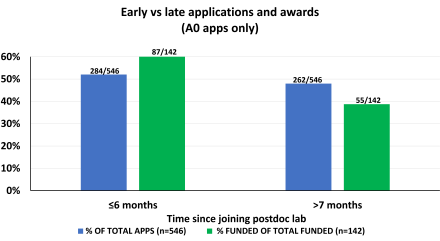
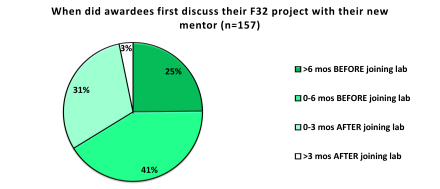
Do you need preliminary data?
- The data in this graph show the percentage of applications submitted, and the percentage of applications funded, with and without preliminary data.
- The % of applications submitted without preliminary data closely tracks the % of awarded applications without preliminary data.
- Therefore the presence of preliminary data does not affect success rate of applications.
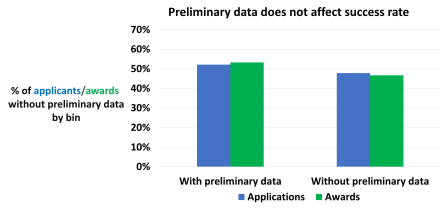
Are applicants who come from "big" labs, or who are joining "big" labs for the F32, at an advantage?
When the NINDS F32 was initiated, with it’s strict, early eligibility limits, there was concern expressed by some that applicants who were coming from “big” or “big name” labs, or those who were entering “big” or “big name” labs, would be advantaged. Our posthoc survey of F32 awardees (n=157) asked how many trainees (defined as graduate students and postdocs) were in awardees previous and current (F32) labs. These data show that the majority of those funded came from very small labs, and the vast majority of those funded were proposing their F32 research to be done in small to mid-size labs.
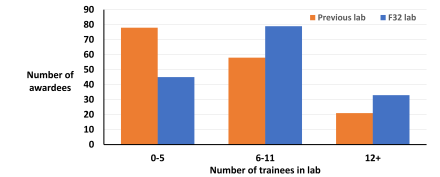
Is having a primary mentor who has little training experience a disadvantage?
The graph below shows that, for primary mentors who are between 11-40 years out from graduating with a doctorate, there is no difference in success rate. Note that the x axis scale is time from PHD, NOT time in faculty position. If one assumes that most investigators spend 5-6 years between obtaining their Ph.D and starting their first faculty position, then most or all of the primary mentors represented in the first bin have been in their faculty positions for less than 5 years. It is not surprising that this cohort, with mentors having close to zero training experience as measured by outcomes, would have a lower success rate. But for those who have held faculty positions for between ~5 and 40 years, there is no difference in success rate based on primary mentor experience.

Are there different success rates for men and women?
There are two simple messages in the table below. Most importantly, the success rates for men and women are similar. Second, more women than men have applied for the NINDS F32. This differs than for all other non-targeted funding mechanisms at NIH, for which there are uniformly more male than female applicants.
| #Applicants | Success Rate | |
|---|---|---|
| Female | 341 | 35% |
| Male | 286 | 31% |
Looking to the future- applying for a K99.
In the 3 FYs before this new F32 mechanism was implemented (FY 14-16), only 24% (54/222) of F32 awardees applied for a K99. However, for F32 awardees through the first 9 council rounds of this new mechanism (i.e from May 2017 to February 2020), 40% (38/94) of F32 awardees have applied for a K99. Thus, there has effectively been a doubling of the % of F32 awardees that apply for a K99. Furthermore, we expect this number to increase in the coming years for 2 reasons; 1) In June of 2020, the eligibility window to submit a K99 was extended due to the COVID-19 pandemic. Undoubtedly F32 awardees from FY 19 and beyond would have been impacted by COVID-19 related lab closures, and will make use of this eligibility extension. 2) In a posthoc survey of F32 awardees from May 2017- October 2023, 71% of respondents stated they will apply for a K99.
In addition, while we cannot state with 100% certainty the reason why awardees for the new F32 mechanism have a higher success rate than awardees of the old F32 mechanism, we strongly believe that having postdocs think early on about the type of research they would like to do, and propose new, bold and creative ideas without the need for preliminary data is a tremendous boost to these individuals as they develop their research career.
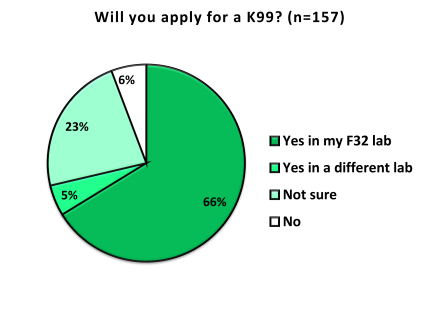
Candidates should carefully read all descriptions, instructions and review criteria in the FOA for an understanding of how the applications will be evaluated.
For additional FAQs see Applying for the NINDS F32.
Contact
Email: NINDS Fellowships
Revisions to the NIH Fellowship Application and Review Process starting on or after January 25, 2025
